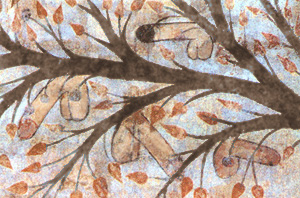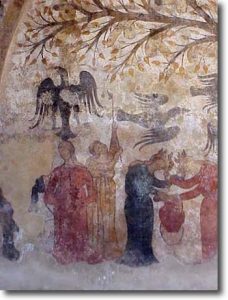A mural that has recently come to light in Tuscany has been identified by a British university lecturer as the earliest surviving representation of witchcraft in Christian Europe. A book published in Italy by George Ferzoco (director of the center for Tuscan studies at the University of Leicester) argues that at least two of the women in the erotic wall painting are sorceresses. “I have no doubt that this is by far the earliest depiction in art of women acting as witches,” Ferzoco says.

The 13th-century mural was discovered on August 6th, 2000, at Massa Marittima, a town south-west of Siena. The large, richly colored painting – seven meters high – was found under layers of subsequent over-painting next to a fountain in the centre of Massa Marittima. It shows a tall, spreading tree with two groups of women standing below it. The first thing that was noticed about the tree was its unusual “fruit,” which is apparently sprouting from the branches as twenty-five phalluses.

Detail of phalluses from painting
Beneath the tree are two groups of women, one standing to the right and the other to the left side of the trunk of the tree. One of the women in the group on the left is holding up a stick with which she appears to be trying to dislodge a bird’s nest. The mural features two of the other women grabbing each other’s hair as they appear to fight for possession over one of the phalluses picked from the tree.

Detail from painting
Ferzoco, after examining this feature, recalled a passage from the inquisitors’ manual known as the Malleus Maleficarum. In its description of witchcraft practices there is an allegation that witches robbed men of their genitals. The passage claims that witches sometimes collect male organs in great numbers (as many as twenty or thirty members). These are placed in a bird’s nest or closed inside a box, where they come alive and are fed oats and corn. Ferzoco commented that “There was a well-known story in Tuscan folklore about witches removing mens’ penises and placing them in bird nests in trees, where they would then multiply and take on a life of their own.” It is noteworthy that the Italian mural was painted two centuries earlier than the writing and publication of the Malleus Maleficarum.
According to Ferzoco the mural is a unique piece of political propaganda, commissioned by one Tuscan faction to sully the reputation of another. He states: “It’s a message from the Guelphs, telling people that if the Ghibellines are allowed power, they will bring with them heresy, sexual perversion, civic strife and witchcraft.”
The Guelphs and Ghibellines were two factions who fought for power in Tuscany and northern Italy for decades during the Middle Ages. Perhaps the most famous victim of their feuds was the poet Dante, a Guelph expelled from his native Florence in 1302 after a rival Guelph group took power. At the time the mural was painted, the Guelphs controlled Massa Marittima, a small town in northwestern Tuscany. According to Ferzoco “They presented themselves as the clean living upstanding party in Tuscan politics and it was traditional for them, in launching their attacks on the Ghibellines, to label them as heretics.”
While Ferzoco’s interpretation of the meaning of the mural is interesting, there are other views to be considered as well. If we accept his opinion that the mural is the earliest depiction in art of women “acting as witches,” what does the imagery reveal about witchcraft beliefs in this period? There are several noteworthy aspects including the absence of the Devil at this assembly of witches. The presence of a magical tree is an important element that reflects the long-standing tradition of the witches tree at Benevento. The imagery of walnuts in their likeness of testicles, and the presence of phalluses in the mural, may be a suggestion of fertility themes linked to witchcraft’s ancient past. The botanical name for walnuts is juglans, which is a Latin name for walnuts. It is derived from the Latin word jovis, meaning “of Jupiter.” In the mural we see eagles, and the eagle was the symbol of the god Jupiter.
The depiction of witches assembled in the mural, along with the absence of the Devil, shares much in common with the early ideas of the witches’ Sabbat before the 16th century. In the early 15th century sermons of Bernardino of Siena we find what may be the first descriptions of Italian witch assemblies in the Christian era. Bernardino uses the Italian term tregenda when he refers to the assembly of witches.
Scholar Franco Mormando writes:
“As to what Bernardino imagined as occurring during the tregenda, we cannot be completely sure, since the notion of the Sabbath was still in its development phase. The friar’s 1424 sermon does not describe this convocation of witches. His later treatise on witchcraft and superstition, De idolatriae cultu (1430-36), contains a reference to the tregenda, though the word itself does not appear in the text. This Latin work nonetheless gives us some idea of his conception of the regular witches assemblies, which eventually evolved into the sabbath.” – The Preacher’s Demons – University of Chicago Press, 1999, page 66
Writing of the Tregenda/Sabbat, Mormando states:
‘‘This notion of the assembly is yet another universal item in ‘the classic formulation of the Witch Phenomenon.’ Like much else in the baggage of the European witch, it has its roots in pagan mythology, specifically in the un-Christian but nondiabolical ‘Society of Diana,’ an innocuous, festive ride and gathering of woman under the tutelage of the pagan goddess of the moon and the hunt. Turned into a demonized witch phenomenon by the theologians and canonists of Christian Europe, the assembly was by the end of the fifteenth century to be known (with tinges of anti-Semitisim) as the witches’ ‘Sabbath.’ With the passing years, it slowly acquired ever more heinous, orgiastic characteristics. During Bernardino’s lifetime, the gathering was called by various names; the preacher himself, in one of his 1424 sermons to the Florentines, refers to it by the Italian term tregenda.” – The Preacher’s Demons, page 66
The records of Bernardino’s sermons are valuable because they pre-date the period from 1560 – 1660, which was the most virulent era of the witch hysteria. Therefore they provide earlier evidence from an obscure realm of history. Mormando comments:
“Note that in Bernardino’s mind, the tregenda has not quite become the sabbath; he makes no explicit mention of the Devil’s presence or of licentious behavior at these meetings of the society of Diana. Nonetheless, he may have assumed, and expected his audience to assume, that neither was really absent from the picture.”
The latter statement is speculation, but is worth noting as a possibility. We do know that the Devil was certainly associated with witchcraft by the Church and its agents during the time of Bernardino. Scholar Walter Stephens writes:
“About 1354, the Dominican preacher Jacopo Passavanti was writing in Italian (in Lo specchio della versa penitenza, or The Mirror of True Repentance) that ‘some people say they see dead people and talk to them, and that they go by night with witches [colle streghe] to their tregenda.’ Many such people are simple impostors, he says: they take advantage of others’ bereavement for financial gain or out of sheer malice. Nonetheless, some people do sincerely think that they see dead people. This is impossible, says Passavanti (presumably because these soul are in hell or purgatory and are not allowed out). But people are seeing something that is real. The Devil can take on the semblance of dead people and falsely impersonate them…” – Demon Lovers – Witchcraft, Sex, and the Crisis of Belief by Walter Stephens (University of Chicago, 2002, page 132)
Stephens goes on to note:
“In fact, the tregenda that Passavanti describes is not what we now call the Sabbat; it is probably a reminiscence of what folklorists call the wild host or wild hunt.” – page 132
This brings us to the troublesome text known as the Canon Episcopi, which most scholars view as a conflation of paganism with witchcraft. Bernardino quotes the Canon text as follows:
“Among the most impious wild brutes are some most wicked women and even sometimes men who believe and openly profess that they go riding at night on certain beasts along with Diana (or Iobiana or Herodias) and countless other women, traveling over great distances in the silence of of the dead night, obeying her commands as if she were their mistress, and are pressed into her service on certain nights, such as Thursday and Sunday. They also claim that some children, especially small boys, can be changed by them into a lower or higher forms (in deterius vel in melius) or transformed into some other appearance or likeness.” – The Preacher’s Demons, page 67
But the idea of souls joined to a goddess figure is very ancient. The goddess Hecate has long been associated with witchcraft and with the crossroads, which appears in legends as a meeting place for souls that cannot pass into the Otherworld. Hecate is depicted in ancient myths as a goddess of the crossroads who guides the dead. It is not difficult to see this gathering of souls as the wild host. The goddess Diana has also been associated with witchcraft by ancient writers, and the concept of a “wild hunt” is certainly not divorced from a goddess associated with hunting (as is the case with the goddess Diana). The ancient writer Lucan even writes of a witch referring to her goddess who is triformis in nature:
“Persephone, who is the third and lowest aspect of our (the witches’) goddess Hekate: Hekate, through whom I can silently converse with the dead…” – (Luc. B.C. 6: 736-38)
The name of the goddess who is not mentioned in Lucan’s reference is undoubtedly the goddess Diana as evidenced in the contemporary writings of the period (and earlier). Here we have not only the presence of a triformis goddess associated with witchcraft in ancient times, but also a starting point with which to begin tracing the Society of Diana.
In the mural of Massa Marittima more questions arise than do answers appear. Still it remains a valuable snap shot of an early period in which the presence of the Devil is not yet a mandatory one when witches are shown in gatherings. Perhaps we are seeing one remnant that suggests the existence of the witches’ sect from a period not yet fully contaminated by its opponents. We may even be seeing something closer and truer to the tregenda in its pagan form (before it became distorted by the inclusion of Judeo-Christian concepts and beliefs, and was thereby transformed into the popular depiction of the witches’ Sabbat).

